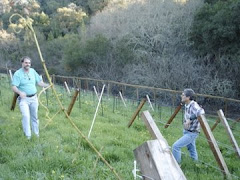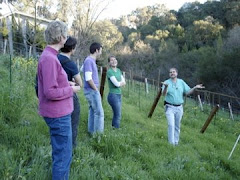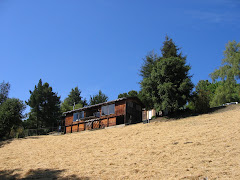Tuesday, May 27, 2008
Saturday, May 24, 2008
Young Oak Vineyards-Vol. 12: Emerging Tendrils!!

Hi all,
Monday, May 19, 2008
Young Oak Vineyards-Vol. 11: Its Growing Season!!
Hi all:
Well the heat is here! And we are at the start of our warm weather growing season. But these grapevines you have planted have not done too shabby during the early spring for the last 78 days. As you can see from the attached photo, we have several cane shoots in full leafy foliage with flower bud clusters as I am holding in my hand. These clusters will soon bloom into tiny flowers from which the fruit (grapes) will swell. I have attached a great photo montage from Michigan State University showing the stages of grapevine development. Check it out:
http://www.grapes.msu.edu/pdf
Next time we will be pruning down to one main shoot on each grapevine and putting on a growth tubes. I ended up purchasing the pink ones (Paris Hilton, you win), but more about that later. I should be receiving them next week, along with my "Gripple" tensioning tool! My neighbor, Mark Vernon, had the super crew from Vinescape plant last week with very interesting techniques to protect the grafted rootstocks. Each rootstock is protected by an empty milk carton, open on each end. Further, the planted rootstock is covered with sawdust inside the milk carton. Those guys really know what they are doing!
Trying to stay cool down in the vineyard,
John
Young Oak Vineyards - Vol. 10: Now, That's A Vineyard. !!!!
http://www.gripple.com/agricult
Gotta love new technology !!
My neighbors Mark & Dianne Vernon, have retained "Vinescape" to install 100 vines adjacent to our vineyard. I can't wait to see what I am doing wrong when these pro's do their thing. They started laying out the vine rows with a laser!! I have to say that some of our planters were not quite laser straight, so we had to move a few of the grapevines!
Hope you all had a nice Easter, restful break and /or a pleasant rite of spring!
Best wishes from down in the vineyard,
John
Young Oak Vineyards - Vol. 9: Botany !!!?!
I have to make a confession now. When I applied for my bachelor's degree in biology, I had never got around to taking botany, a required class for the degree. Since I was entering the graduate program at the same institution, they gave me my bachelor's anyway, but required me to take botany as a graduate course before I could advance in my master's program. At about half of a semester into graduate program, I grew weary of another 2 to 3 years of college, so withdrew and follow my nose into the field of ?:
AGGIE YELL [Hands flat, with index
Texas & Football, what can I say!
Young Oak Vineyards - Vol. 8: Thank You !!!!!!!!!!!!!!!!!!!!!! and more !
Yes, this weekend almost every grapevine has budded with 1, 2, 3, 4, even 5 buds! I have attache a picture of one of the grafted shoots and there, opposite my finger, a third way up from the root stock graft is a big bud. There is also a smaller one on the base of the shoot below my finger.
As you can see in the picture, along my arm we have put in the main drip lines along each row. I am still plumbing away to get the entire watering system connected, so I don't have to water by hand much longer! So, I will keep you posted as things progress in the Spring. We will finish the watering system in a week or two. Then, the trellis wires are going in. And finally we have to have the discussion about "Grow Tubes"!! Should they be blue or pink!! And it is not a decision for Paris Hilton! Regards from the vineyard, John
Young Oak Vineyards - Vol. 7: Trelli?

Young Oak Vineyards - Vol. 6: Preparing the Soil

An acre, from the Old English for an "open field", is defined as the amount of land that is tillable by one man with an ox drawn plow in one day. Well, I could have used that ox this last week! I had trouble finding someone willing to disc our field this early in the season. And although the weather has been pretty dry for last couple of weeks, it is dangerous to operate a wheeled tractor on a slick hillside. What I needed was a "crawler tractor" with treads like a tank, but the few tractor services around here were unable or not willing to start this early. As I was panicking about what I could do, I actually found a community college professor in Marin County who plows his own fields with his team of Clydesdale horses (holy Budweiser!), but the logistics of moving his team of horses was not possible.
Some 5000 years ago some prehistoric farmer got the idea of hitching his ox to his digging stick. Primitive stick plows still are used in some parts of the world. The ancient Romans shod the point with iron or bronze to protect it from wear. The Dutch improved the Roman plow, who needed a different shape for their soils. The colonial plow was a heavy wooded & wrought iron 10' long beam. It took several teams of horses or oxen to pull it & often needed repairs. In 1797, a plow of solid cast iron was patented in New Jersey & soon after Thomas Jefferson invented one which could be pulled more easily. In the western expansion of North America, this plow could not successfully break the tough sod formed by the matted roots of the prairie grasses. Even with 5-10 oxen pulling, the sticky black soil clung to the plow and had to be scraped off every few steps. John Lane made a plow with polished steel circular saw blade which would "scour" the soil off the plough without cleaning (what we know as discing today). In 1837, John Deere, a blacksmith of Grand Detour, Illinois, made further improvements and founded the now famous farm implement company.
One more thing to do before we plant and that is to get the trellis set up and we will discuss that next week!
Regards, John
Young Oak Vineyards - Vol. 5: Grafting Clones
 We left off with the question of what is a grapevine "clone". Sounds like something from "Dolly the Sheep" !! But "vegetative cloning" has been done for thousands of years. The earliest record of grafting is from China around 5,000 B.C by a diplomat's work on peach trees. The Romans were famous for their grafted olive trees.
We left off with the question of what is a grapevine "clone". Sounds like something from "Dolly the Sheep" !! But "vegetative cloning" has been done for thousands of years. The earliest record of grafting is from China around 5,000 B.C by a diplomat's work on peach trees. The Romans were famous for their grafted olive trees. 
Attributes - Good choice for diversification. Lowest yielding cab clone (60% of Clone 7 or 8). Best on high density spacing. Excellent wine quality. High skin to pulp ratio. Small to medium size, loose clusters, variable size berries
This is a really nice, high quality Cabernet Sauvignon grape. Its yield (the number and size of grapes) is less than other clones, but the wine it produces is superior. The #3309C rootstock needs good drainage and I think that with our slope we will have that. And although it is not the "La Cuesta" clone, this is a really high end grape used in very fine wines! Sounds good to me, so ... , this is what we bought and what you will be planting in 18 days!! My son, Scott & I will be picking up our vines on Friday, February 29th, fresh from the nursery !! They are already propagated little potted plants, that can be planted anytime of the year, so let's do it !!
Regards from down in the vineyard, John Sphar
Young Oak Vineyards - Vol. 4: Rootstock
First a little background information. The native grapes of North America, generally known as "Foxy Grapes", don't make particularly good wines. And the grapes grown in Europe, Vitis vinifera, which make really good wines, didn't & don't do very well when they tried to grow them here, recorded as early as the 16th century by the French in their new colony, Florida. Even Jefferson had difficulty growing grapes at his beloved Monticello. He planted more than 24 European grape varieties, and considered wine was "necessary of life". But as noted in his Garden Book, constant replanting of the vines indicated that they didn't grow well and there is no record of wine ever being produced. Further, he noted that growing grapes for wine was "like gambling". By the way, during 1801, his first year as President, Jefferson spent $2,262 on imported wine, more than he did on food. Presidents of the time were required to furnish food and drink for the President House staff and guests out of their own salaries. During his eight years in office he spent $10,955 on imported wine; in 2008 currency that would amount to more than $175,000.
It turns out that the Grape Phylloxera, or Daktulosphaira vitifoliae, a native North American aphid, killed off the European grapevines when they were grown here. Our little aphid would eventually spread to Europe by 1870's, almost destroying the French wine industry. Too make a long story short, our North American native grapes, are resistant to Phylloxera. Eventually, someone figured out that the European grapevines, Vitis vinifera, could be grafted onto these "Foxy Grapes" roots, which made it possible to grow European grapes here. Too bad the French didn't listen to Spanish, who were grafting Spanish grapevines onto Mexican native rootstock as early as 1524.
Armed with my list of recommended rootstocks, I did a Google search for grape rootstock and found Duarte Nursery, located near Modesto, CA, which happens to be "the place" to go for wine grapes rootstocks. I wanted to find one of my recommended rootstocks grafted with the "La Cuesta" Cabernet "clone", which gives rise to the question, what is a "clone" and how do you "graft" it? But I will save that for next time!
Regards from down in the vineyard (and it really is looking like a vineyard now!),
Young Oak Vineyards - Vol. 3: The Lay of the Land
We are working hard here at the vineyard. What struck me about this property when I first saw it, is that it had a perfect southwest exposure for maximum sunlight on a hillside ridge with a 10 degree slope. What was left of an old fruit orchard that had been on the land, was a few rotting stumps of apricots & other fruit trees here and there, but otherwise it has been in fallow, uncultivated, for 50+ years. The story we heard was that when the house was for sale and when the realtor showed it, the clients often never got out of the car, because the house was, shall we say "unsightly". Fortunately for us, there were no other buyers attracted to the potential of the property.
In fact, our soils analysis came back "normal", that is to say there was nothing to worry about. Although the calcium level is unusually high, probably from amendments from the orchard period, but there is no need to amend the soil. The deer fencing is almost completed and we are starting to build a rail road tie stairway down to the vineyard. And then the plan is to "weed-wack" the new crop of grass in mid to late February, depending on when the rain let up. My backyard neighbor, Brian, has offered to loan me his tractor to rototill the vineyard. After the soil is ready, we will put in the trellising and drip lines to be ready for planting. We will be sending out an e-Vite soon with all the particulars for the upcoming planting party!
From down in the (future) vineyard,
Young Oak Vineyards - Vol. 2: The Adventure Begins
First of all, congratulations to all the Escondido Elementary School PTA auction winners who successfully bid on the Emery-Sphar Vineyard Planting Party. By your efforts, you have helped raise a $1,000 towards an auction total of over $60,000 for our children's school. We are really looking forward to a wonderful day of a little work, great food, conversations, music & celebration with you, our friends & family!
However, it was my college days, sippin' wine, looking at world maps & reading National Geographic with my buddy Al, that really caught me up in the enjoyment of wine! I took Vitaculture 101 - Intro. to Wine, from Professor Singleton at UC-Davis. Prof. Singleton had written our text and had introduced many innovations in fermentation techniques, although the only one I can remember was his idea about adding oak chips to the huge stainless steel tanks that the bulk winemakers use (actually, not so memorable!).
From down in the (future) vineyard,
Young Oak Vineyards - Vol. 1: In The Beginning
Hi all:
As some of you know, we were able to buy a little land in the hills with a run down house that I will be spending the next 20 years remodeling. But here's the thing, we have a perfect south western exposed hillside for grapes and the only thing that is keeping me from putting in a vineyard is all the work & labor (which I should be putting into the house).
So far I have had my soil analyzed and I have too much calcium (possibly a natural geologic phenomenon of the clay around here), so we may have to add some other amendments. I am getting an amendment recommendation from my neighbor, who is with Ridge Winery, actually from his vineyard master. They are also going to recommend a particular varietal best suited for our soil, either Zinfandel or probably Cabernet Sauvignon and probably a clone of the "La Cuesta" Cabernet of Woodside, which I think Dr. Fogerty of Fogerty Winery developed.
Then I got this great idea to "out source" much of the labor as a fund raising item at our daughter's elementary school PTA auction! So, with a little creative packaging we have created an event!! Here is the copy for the auction listing:
This is for all those oenophiles out there. How cool is this? Mark your calendars for Saturday, March 1 for a phenomenal day all about wine from start to finish. BYOS (bring you own shovel!) and plant 8-10 grapevines each at the home vineyard of Kristen Emery and John Sphar. Follow up with a luncheon with Mark Vernon, COO of Ridge Vineyards and Winery, Ltd., for a discussion of wine and wine tasting. For families with young children, they will be entertained by John and Kristen's children. Even better, you'll receive a couple of bottles of the first vintage in about five years after the vines mature!
At any rate, we would love to have all our family & friends join us as well along with the hired help (20 auction winners). It should be a fun day and we hope you all can come. I'll send you details as we get closer to the date, but I gotta get back to diggin' fence posts!
Best regards,
John
Young Oak Vineyards Starts A Blog!
I am switching from my e-mail blast to a blog format for the goings on at Young Oak Vineyards. I too can be like Arianna Huffington! View all my e-mail blasts, now blogs above. I have put the real date of publication within the blogs.
The warm growing season is upon us here in Los Altos Hills, CA, after our first heat wave of the 2008 hitting over a 100 degrees. Its a little cooler today with our typical morning fog kissing the coastal hills and a high today in the low 90's, helped by a gentle breeze. Hope all of you are healthy & well.
Regards from down in the vineyard,
John





























































































































